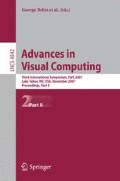Abstract
Several techniques have been proposed to date to build colour invariants between camera views with varying illumination conditions. In this paper, we propose to improve colour invariance by using data-dependent techniques. To this aim, we compare the effectiveness of histogram stretching, illumination filtration, full histogram equalisation and controlled histogram equalisation in a video surveillance domain. All such techniques have limited computational requirements and are therefore suitable for real time implementation. Controlled histogram equalisation is a modified histogram equalisation operating under the influence of a control parameter [1]. Our empirical comparison looks at the ability of these techniques to make the global colour appearance of single human targets more matchable under illumination changes, whilst still discriminating between different people. Tests are conducted on the appearance of individuals from two camera views with greatly differing illumination conditions and invariance is evaluated through a similarity measure based upon colour histograms. In general, our results indicate that these techniques improve colour invariance; amongst them, full and controlled equalisation consistently showed the best performance.
Access this chapter
Tax calculation will be finalised at checkout
Purchases are for personal use only
Preview
Unable to display preview. Download preview PDF.
References
Madden, C., Cheng, E.D., Piccardi, M.: Tracking people across disjoint camera views by an illumination-tolerant appearance representation. Machine Vision and Applications 18, 233–247 (2007)
Abdel-Hakim, A.E., Farag, A.A.: Csift: A sift descriptor with color invariant characteristics. International Conference on Computer Vision and Pattern Recognition 2, 1978–1983 (2006)
Finlayson, G., Hordley, S., Schaefer, G., Tian, G.Y.: Illuminant and device invariant colour using histogram equalisation. Pattern Recognition 38, 179–190 (2005)
Barnard, K., Funt, B.: Camera characterization for color research. Color Research and Application 27, 153–164 (2002)
Bala, R.: Device characterization. In: Sharma, G. (ed.) Digital Color Imaging Handbook, CRC Press, Boca Raton, USA (2003)
Javed, O., Rasheed, Z., Shafique, K., Shah, M.: Tracking across multiple cameras with disjoint views. IEEE Conference on Computer Vision and Pattern Recognition 2, 26–33 (2005)
Javed, O., Rasheed, Z., Shafique, K., Shah, M.: Tracking across multiple cameras with disjoint views. International Conference on Computer Vision 2, 952–957 (2003)
Weiss, Y.: Deriving intrinsic images from image sequences. International Conference on Computer Vision 2, 68–75 (2001)
Barnard, K., Funt, B., Cardei, V.: A comparison of computational colour constancy algorithms; part one: Methodology and experiments with synthesized data. IEEE Transactions in Image Processing 11, 972–984 (2002)
Toth, D., Aach, T., Metzler, V.: Bayesian spatiotemporal motion detection under varying illumination. In: European Signal Processing Conference pp. 2081–2084 (2000)
Zhou, S.K., Chellapa, R.: From sample similarity to ensemble similarity: probabilistic distance measures in reproducing kernel hilbert space. IEEE Transactions on Pattern Analysis And Machine Intelligence 28, 917–929 (2006)
Wren, C., Azarbayejani, A., Darrell, T., Pentland, A.P.: Pfinder: real-time tracking of the human body. IEEE Transactions on Pattern Analysis And Machine Intelligence 19(7), 780–785 (1997)
Author information
Authors and Affiliations
Editor information
Rights and permissions
Copyright information
© 2007 Springer-Verlag Berlin Heidelberg
About this paper
Cite this paper
Madden, C., Piccardi, M., Zuffi, S. (2007). Comparison of Techniques for Mitigating the Effects of Illumination Variations on the Appearance of Human Targets. In: Bebis, G., et al. Advances in Visual Computing. ISVC 2007. Lecture Notes in Computer Science, vol 4842. Springer, Berlin, Heidelberg. https://doi.org/10.1007/978-3-540-76856-2_12
Download citation
DOI: https://doi.org/10.1007/978-3-540-76856-2_12
Publisher Name: Springer, Berlin, Heidelberg
Print ISBN: 978-3-540-76855-5
Online ISBN: 978-3-540-76856-2
eBook Packages: Computer ScienceComputer Science (R0)

